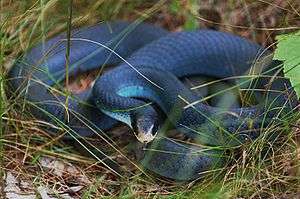Colubroides
The Colubroides are a clade in the suborder Serpentes (snakes).[3] It contains over 85% of all the extant species of snakes.[4][3][5] The largest family is Colubridae, but it also includes at least six other families[3][6], at least four of which were once classified as "Colubridae" before molecular phylogenetics helped us understand their relationships.[7][8][9][10] It has been found to be monophyletic.[4][11][12][13][14]
| Colubroides | |
|---|---|
 | |
| Eastern racer (Coluber constrictor) | |
| Scientific classification | |
| Kingdom: | Animalia |
| Phylum: | Chordata |
| Class: | Reptilia |
| Order: | Squamata |
| Suborder: | Serpentes |
| Clade: | Caenophidia |
| Clade: | Colubroides Zaher et al., 2009[1] |
| Subclades | |
| |
| Synonyms[2] | |
|
Xenophidia | |
Morphological synapomorphies are defined as such from Zaher et al. (2009):[1]
Loss of the right carotid artery; intercostal arteries arising from the dorsal aorta throughout the trunk at intervals of several body segments; specialized expanded costal cartilages; presence of a muscle protractor laryngeus; separate muscle protractor quadrati; separate spinalis and semispinalis portion in the epaxial trunk; spinules or spines covering the hemipenial body.
Traditionally the name "Colubroidea" was used for this clade. This was seen problematic, however, as many of the same studies that support this clade of snakes also advocated for the various subfamilies of Colubridae to be reevaluated as proper families in their own right.[1][15][13] As the result of this, Zaher et al. (2009) proposed to rename the clade as "Colubroides", restricting Colubroidea to the clade Colubridae and several related families that were formerly colubrid subfamilies.[1][15][13]
Below is a phylogeny of colubroid snakes found in many analyses:[1][15][13]
| Colubroides |
| ||||||||||||||||||||||||||||||||||||||||||||||||||||||||||||||||||||||||||||||||||||||||||||||||||||||||||||||||||||||||||||||||||||||||||||||||||||||||||||||||||||||||||||||||||||||||||||||||||||||||||||||||||
References
- Zaher, H.; Grazziotin, F. G.; Cadle, J. E.; Murphy, R. M.; Cesar de Moura-Leite, J.; Bonatto, S. L. (2009). "Molecular phylogeny of advanced snakes (Serpentes, Caenophidia) with an emphasis on South American Xenodontines: a revised classification and descriptions of new taxa". Papéis Avulsos de Zoologia. 49 (11): 115–153. doi:10.1590/S0031-10492009001100001.
- "Scientific name: Xenophidia". The Taxonomicon. Retrieved 2016-12-19.
- Uetz, Peter. "Serpentes at The Reptile Database". The Reptile Database. EMBL. Retrieved 14 May 2018.
- Lawson, Robin; Slowinski, Joseph B.; Crother, Brian I.; Burbrink, Frank T. (2005). "Phylogeny of the Colubroidea (Serpentes): new evidence from mitochondrial and nuclear genes" (PDF). Molecular Phylogenetics & Evolution. 37 (2): 581–601. doi:10.1016/j.ympev.2005.07.016. PMID 16172004. Archived from the original (PDF) on 2014-08-19. Retrieved 2019-03-04.
- "Colubroidea". Integrated Taxonomic Information System. Retrieved 14 May 2018.
- Pyron, R. Alexander; et al. (2011). "The phylogeny of advanced snakes (Colubroidea), with discovery of a new subfamily and comparison of support methods for likelihood trees" (PDF). Molecular Phylogenetics and Evolution. 58 (2): 329–342. doi:10.1016/j.ympev.2010.11.006. PMID 21074626. Archived from the original (PDF) on 3 October 2013.
- Scanlon, J. D.; Lee, M. S. Y. (2011). Aldridge, R. D.; Sever, D. M. (eds.). The Major Clades of Living Snakes: Morphological Evolution, Molecular Phylogeny, and Divergence Dates in Reproductive Biology and Phylogeny of Snakes. Enfield, NH: Science Publishers. pp. 55–95.
- Vidal, N.; Delmas, A. S.; Hedges, S. B. (2007). Henderson, R. W.; Powell, R. (eds.). The higher-level relationships of alethinophidian snakes inferred from seven nuclear and mitochondrial genes. Eagle Mountain, Utah, USA: Eagle Mountain Publishing. pp. 27–33.
- Vitt, L. J.; Caldwell, J. P. (2014). Herpetology: an introductory biology of amphibians and reptiles (4th ed.). Burlington: Academic Press. pp. 108–109.
- Reynolds, RG; Niemiller, ML; Revell, LJ (2014). "Toward a Tree-of-Life for the boas and pythons: multilocus species-level phylogeny with unprecedented taxon sampling" (PDF). Molecular Phylogenetics and Evolution. 71: 201–213. doi:10.1016/j.ympev.2013.11.011. PMID 24315866. Archived from the original (PDF) on 2015-12-02. Retrieved 2019-03-04.
- Pyron, R. A.; Burbrink, F.; Wiens, J. J. (2013). "A phylogeny and revised classification of Squamata, including 4161 species of lizards and snakes". BMC Evolutionary Biology. 13: 93. doi:10.1186/1471-2148-13-93. PMC 3682911. PMID 23627680.
- Streicher, J. W.; Ruane, S. (2018). "Phylogenomics of Snakes". eLS: 1–8. doi:10.1002/9780470015902.a0027476. ISBN 9780470015902.
- Figueroa, A.; McKelvy, A. D.; Grismer, L. L.; Bell, C. D.; Lailvaux, S. P. (2016). "A species-level phylogeny of extant snakes with description of a new colubrid subfamily and genus". PLOS ONE. 11 (9): e0161070. Bibcode:2016PLoSO..1161070F. doi:10.1371/journal.pone.0161070. PMC 5014348. PMID 27603205.
- Zheng, Y; Wiens, JJ (2016). "Combining phylogenomic and supermatrix approaches, and a time-calibrated phylogeny for squamate reptiles (lizards and snakes) based on 52 genes and 4162 species" (PDF). Molecular Phylogenetics and Evolution. 94 (Pt B): 537–547. doi:10.1016/j.ympev.2015.10.009. PMID 26475614.
- Grazziotin, F. G.; Zaher, H.; Murphy, R. W.; Srocchi, G.; Benavides, M. A.; Zhang, Y.; Bonatto, S. L. (2012). "Molecular phylogeny of the new world Dipsadidae (Serpentes: Colubroidea): a reappraisal". Cladistics. 28 (5): 437–459. doi:10.1111/j.1096-0031.2012.00393.x.